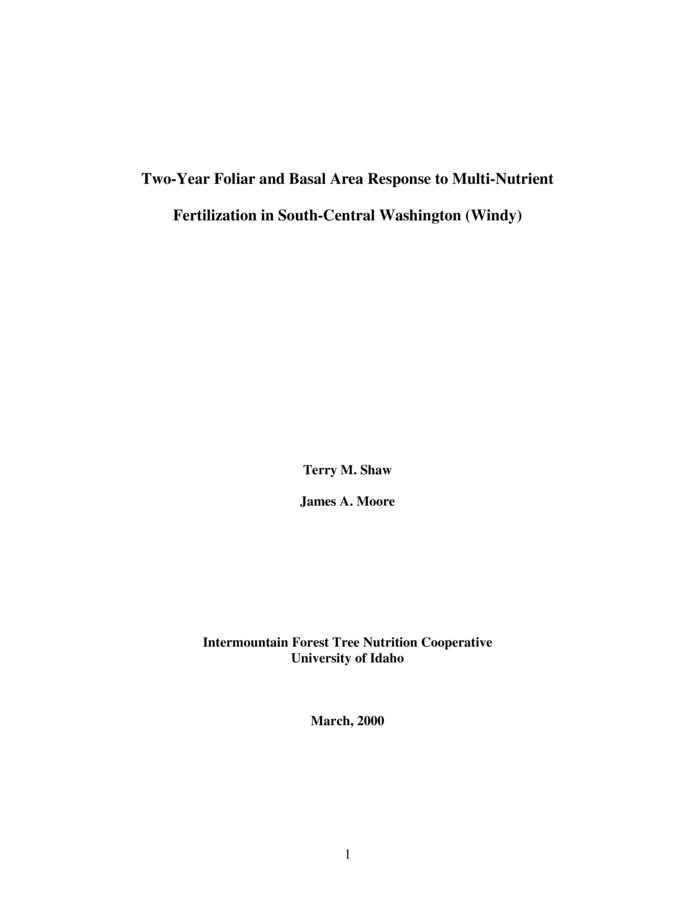PDF
Two-Year Foliar and Basal Area Response to Multi-Nutrient Re-fertilization for Douglas-fir in South-Central Washington (Windy) Item Info
- Title:
- Two-Year Foliar and Basal Area Response to Multi-Nutrient Re-fertilization for Douglas-fir in South-Central Washington (Windy)
- Creator:
- Terry M. Shaw; James A. Moore
- Date Created (ISO Standard):
- 2000-03-01
- Description:
- Significant foliar nutrient response due to fertilization was seen for N, S, B and Cu for Douglas-fir and N, K, S and Cu for ponderosa pine. Nutrient concentration response was generally higher two growing seasons after fertilization than it was after one growing season. The low N application rate (90#/ac) did not significantly increase N concentrations above controls. Those plots receiving the 300#/ac N application rate showed imbalanced K/N and N/S ratios after treatment. Different application rates of K did not appear to significantly change K concentrations following treatments. Foliar analysis also showed deficiencies before treatment as well as treatment induced deficiencies for all the nutrients applied in this study. According to published nutrient critical levels; N, S and B were deficient for Douglas-fir, while S, B, Cu and Zn were deficient for ponderosa pine. Phosphorus, Ca, Mg, Zn and Mo concentrations were lower on all the fertilized treatments compared to the control. In addition, vector analysis diagnoses of foliar response revealed S, Cu and Mo deficiencies for Douglas-fir and N, K and Mo deficiencies for ponderosa pine. Nutrient dilution vectors occurred for all nutrients relative to the N-Alone treatment. The fertilizer treatments were successful in significantly (p < 0.10) increasing foliar needle weights above that of the control for all treatments having micro-nutrients in the fertilizer mix. Similar to foliar nutrient response, needle weight response tended to be higher two growing seasons after fertilization than it was after one growing season. Importantly, only treatments that included micro-nutrients produced significant (p < 0.10) needle weight increases in 1998 for both Douglas-fir and ponderosa pine. Delayed foliar nutrient and needle weight responses may be due to spring fertilization, where the effects of fertilizer treatments may not have been established early or long enough in 1997 for the trees to show a strong response at the end of one growing season. Two-year net and gross average basal area response was highest on the K-Alone and N-Alone treatments with 29% and 16% increases over the control, respectively. Basal area response was unsignificant (p < 0.10) and less than 10% on those treatments having micro-nutrients in the fertilizer mix. Low two-year basal area response on the micro-nutrient treatments may be attributed to delayed foliar nutrient and needle weight responses due to spring fertilization. Forthcoming results that include both diameter and height response measurements may provide better information.
- Source:
- Shaw, T.M. and J.A. Moore. 2000. Two-Year Foliar and Basal Area and Growth Response to Multi-Nutrient Fertilization in South-Central Washington (Windy). IFTNC, College of Natural Resources, Univ. of Idaho, Moscow.
- Source Identifier:
- 2000_ Shaw _WINDY 2yr fol-growthIFTNC
- Type:
- Text
- Format:
- application/pdf
Source
- Preferred Citation:
- "Two-Year Foliar and Basal Area Response to Multi-Nutrient Re-fertilization for Douglas-fir in South-Central Washington (Windy)", Intermountain Forestry Cooperative, University of Idaho Library Digital Collections, https://www.lib.uidaho.edu/digital/iftnc/items/iftnc3356.html
Rights
- Rights:
- This document is provided by the University of Idaho Library for use by University of Idaho students, staff, and faculty. All rights to the document linked from this metadata belong to the author, rights holder, and/or provider. For more information contact The Intermountain Forestry Cooperative, https://www.uidaho.edu/cnr/ifc
- Standardized Rights:
- http://rightsstatements.org/vocab/InC-EDU/1.0/

